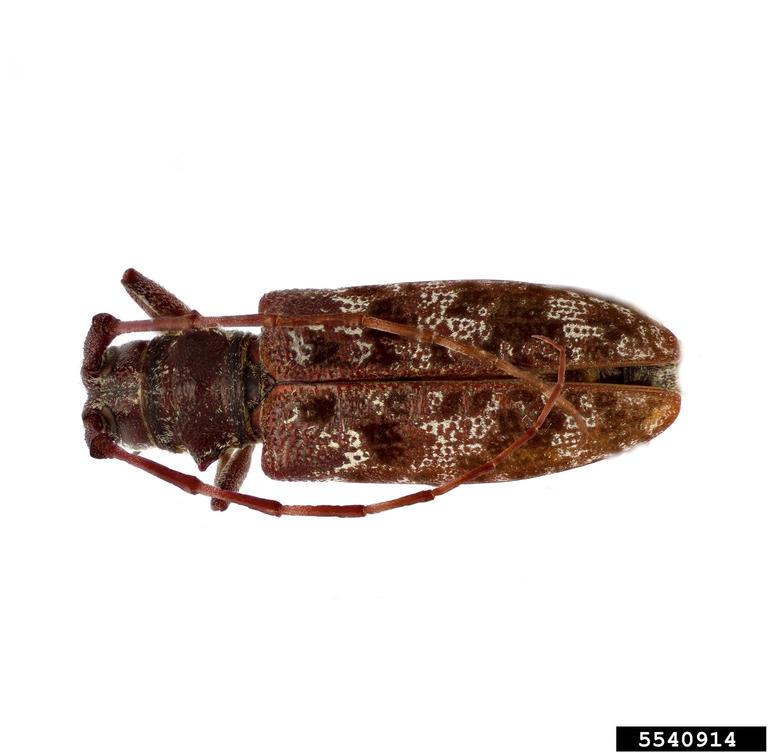Monochamus obtusus (obtuse sawyer)
Identity
- Preferred Scientific Name
- Monochamus obtusus Casey
- Preferred Common Name
- obtuse sawyer
- Other Scientific Names
- Monochamus fulvomaculatus Linsley
- Monohammus obtusus Schaeffer
- EPPO code
- MONCOB (Monochamus obtusus)
Pictures

Monochamus obtusus
Joseph Benzel, Colorado State University, bugwood.org
Refer to Bugwood: http://www.bugwood.org/ImageUsage.html
Distribution
Host Plants and Other Plants Affected
| Host | Host status | References |
|---|---|---|
| Abies concolor (Rocky Mountain white fir) | Main | |
| Abies grandis (grand fir) | Main | |
| Pinus contorta (lodgepole pine) | Main | |
| Pinus coulteri (big-cone pine) | Main | |
| Pinus lambertiana (big pine) | Main | |
| Pinus ponderosa (ponderosa pine) | Main | |
| Pinus sabiniana (Digger pine) | Main | |
| Pseudotsuga menziesii (Douglas-fir) | Main |
Symptoms
Conifers that are severely stressed, dying, or recently killed are vulnerable to attack. The late-instar larvae produce excelsior-like frass, which is extruded to the surface and out of the gallery. These borings accumulate and form small piles below each gallery and are a clear indication of an infested tree or log. In the areas where the beetle populations are very high, adult feeding on the tender bark of conifer twigs results in twig death and produces what is often called 'flagging'. Under extreme conditions, especially when the tree is already weak, adult feeding on the twigs and foliage can result in the death of the tree.
List of Symptoms/Signs
| Symptom or sign | Life stages | Sign or diagnosis |
|---|---|---|
| Plants/Leaves/external feeding | ||
| Plants/Stems/internal feeding | ||
| Plants/Whole plant/frass visible | ||
| Plants/Whole plant/internal feeding | ||
| Plants/Whole plant/plant dead; dieback |
Prevention and Control
Control recommendations have been developed for the whitespotted sawyer beetle, Monochamus scutellatus by Cerezke (1975), Ostaff and Shields (1978) and references therein. These methods are also applicable to M. obtusus. Chemical insecticides and cultural techniques have controlled the damage by Monochamus beetles. However, current methods of control rely on cultural practices because the pesticides are no longer available or considered too harmful to the environment.Serious economic damage to saw logs does not occur until the larvae begin boring into the sapwood, which is typically in mid to late August. The trees cut in the spring and processed into lumber before then, will not suffer damage. If logging practices do not permit the rapid cutting, handling, and processing of logs, the logs should be stored in high compact decks immediately after cutting. Decking of the logs reduces the surface area available for egg laying and increases shading, which also reduces oviposition. Further protection can be achieved if the decks are placed inside shaded portions of the forest. The more compact the deck of logs is, the less likely the adults will be able to penetrate the deck more than two or three logs deep to lay eggs. The damage in loosely packed decks may occur all the way to the ground. By covering the log deck with slash (about 50 cm deep), shading can be provided. However, this reduces air circulation and drying, which in turn may increase stain and decay. The logs that are cut after oviposition in the autumn and early winter are less attractive to Monochamus than logs cut later in the winter or early spring. These logs can be given lower priority to move out of the woods or can be used to top the log decks. In log yards, continuous sprinkling of the log decks during the egg-laying period discourages oviposition and thus damage. The storage of logs in water was once common but is no longer in use because of leached phenols and tannins into the water, accumulated bark debris, navigational hazards and reduced aesthetic value. In log yards, the use of semiochemicals (message-bearing chemicals) to mass-trap beetles is currently under development (Allison et al., 2001, 2003; de Groot and Nott, 2001, 2003; McIntosh et al., 2001; Morewood et al., 2002). Mass-trapping uses attractants to lure adults into traps where they would be captured and killed.Generally, kiln drying of commercial lumber is effective in killing all the stages of Monochamus in wood. Heat sterilization at temperatures greater than 60°C for 2 hours or more, will kill live insects.
Impact
The economic impact of M. obtusus has not been determined. The surface galleries and shallow tunnelling by the early instars are sawn off with the slabs and this consequently results in no loss of value in saw timber. The larval galleries that are bored deeper into the wood will downgrade veneer logs to saw logs. The presence of one larval gallery in a pole log will result in its rejection as a utility pole (e.g. electrical power or communication poles). In general, as the log diameter increases, the greater the proportion of lumber that is free of larval gallery holes. The damage by the widespread and very common whitespotted sawyer, Monochamus scutellatus, can decrease the wood volume of pulp logs by 5% and reduce the value of lumber products by 30% (Wilson, 1962; Cerezke, 1975). Similar losses on a log basis can be expected for M. obtusus. A sequential sampling plan to estimate the severity of log damage by larvae of Monochamus is presented by Safranik and Raske (1970).
Information & Authors
Information
Published In
Copyright
Copyright © CABI. CABI is a registered EU trademark. This article is published under a Attribution-NonCommercial-NoDerivatives 4.0 International (CC BY-NC-ND 4.0)
History
Published online: 21 November 2019
Language
English
Authors
Metrics & Citations
Metrics
SCITE_
Citations
Export citation
Select the format you want to export the citations of this publication.
EXPORT CITATIONSExport Citation
View Options
View options
Get Access
Login Options
Check if you access through your login credentials or your institution to get full access on this article.


